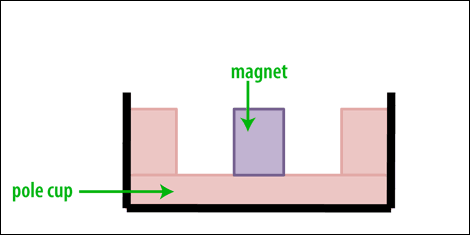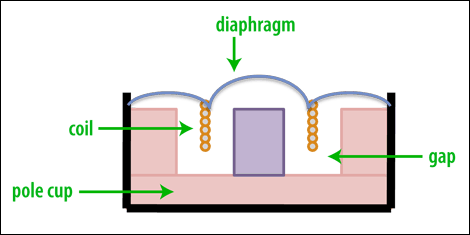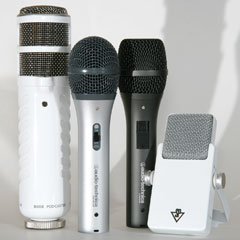
How a Dynamic Microphone Works
Wednesday, October 31st, 2012 | by Peterson Goodwyn
matthew mcglynn
The SM57 is probably the most common microphone on the planet. Have you ever wondered what’s going on inside?
Peterson Goodwyn, who you might know from SoundHow or DIYRecordingEquipment, spent a day at Shure’s headquarters to answer that very question. He met with John Born, Shure’s Product Specialist for wired microphones. The two shot a three-part video series about the inner workings of the best-known dynamic mic in the world. We have Part I below, with the subsequent chapters to follow over the next two days.
- How a Dynamic Microphone Works – a tour of the components, from the diaphragm to the transformer
- Creating directionality and frequency response through clever engineering
- The 50-year old secret behind Shure’s invisible internal shockmount
How a Dynamic Microphone Works
Transcript
This is a transcription of Peterson Goodwyn’s interview with John Born, product specialist for Shure, Inc. Parts II and III of this interview will follow over the coming days.
Hello, and welcome to RecordingHacks. I’m Peterson Goodwyn from DIYRecordingEquipment, and today I am thrilled and priviledged to be at Shure headquarters, 10 miles underground, with John Born, Product Specialist and Engineer. We’re going to be talking about dynamic microphones. And who better to be talking about them with than someone from Shure, who are of course well-known for the SM57, SM58, SM7, and lots of other dynamic mics. So, thank you, John.
JB: Thanks for coming out.
Well, let’s jump right into it. I was thinking it would be cool to talk about this as if I’m going through the microphone as a sound wave. And then we’ll do a “sound wave’s point of view” through the microphone. So, let’s say I’m talking right on the microphone, and for the moment let’s ignore all the real-world problems like directionality and all that. Say I am a soundwave hitting the microphone. What happens?
 JB: We can’t talk about that unless we talk about the components of a dynamic mic. And there are a few important ones that we need to call out. Mainly, being the magnet. That sits inside something called the pole piece, or pole cup. That holds the magnet, and directs the magnetic field that is being created by that magnet.
JB: We can’t talk about that unless we talk about the components of a dynamic mic. And there are a few important ones that we need to call out. Mainly, being the magnet. That sits inside something called the pole piece, or pole cup. That holds the magnet, and directs the magnetic field that is being created by that magnet.
[Then] we have the diaphragm. That’s typically made out of mylar.
That’s what I hear crinkling there?
JB: Yeah, that was me crinkling the diaphragm. It doesn’t affect the response, though — it’s going to be fine.
Attached to that diaphragm is a voice coil, and that is normally a loop of wire, normally made out of copper, or aluminum, or copper-clad aluminum of some sort.
Conductive wire.
 JB: Some sort of conductive wire. That coil of wire is attached to the diaphragm, and it sits around the magnet. It doesn’t touch the magnet, and it doesn’t touch the pole piece, but it sits in what we call the “gap.”
JB: Some sort of conductive wire. That coil of wire is attached to the diaphragm, and it sits around the magnet. It doesn’t touch the magnet, and it doesn’t touch the pole piece, but it sits in what we call the “gap.”
That magnetic field is perpendicular to the coil, so it inducts a voltage onto that coil.
The sound hits the diaphragm, and changes the voltage inside that magnetic field. We can capture tha voltage. We basically take two leads off of that coil, and [that gives us] some sort of voltage that we can work with.
OK, so that was a very quick run through the microphone! Let’s just break down a couple of those things before we move on. So we’re a sound wave, an acoustical, mechanical phenomenon: what’s the first thing we hit?
JB: The first thing we hit, besides the resonator cap, which we’ll get into later, the first thing you hit is the diaphragm.
At this point [the sound is] still a mechanical vibration, right?
JB: Yes, still a mechanical vibration at that point.
So we’re moving the Mylar, a very thin diaphragm, which is attached to a coil of wire. This is where we’re “transducing,” right? We’re turning one form of energy, acoustical, into another form. What’s happening right here?
JB: Right now, that acoustical energy is actually moving the diaphragm. We wouldn’t be able to see it, but it does move the diaphragm. Because that coil is attached to that diaphragm, [the sound wave] is going to move that coil also.
What turns [the acoustic energy] into electrical energy is that magnet. That magnet, being perpendicular to the coil, is creating a magnetic field. We’re directing that magnetic field with the pole piece. We’re directing the mass of that magnetic flux through the gap, right into where the coil sits. By creating that magnetic field, and inducing it onto that coil, as the sound changes the pressure of the diaphragm, it changes the voltage along the coil.
So that’s just a property of the world, that when you have [a] changing magnetic field you get a changing electrical current?
JB: Yes. When you create a magnetic field perpendicular to some conductive [apparatus like a] wire or coil, you can create voltage across that wire. Just like a speaker works, similar to a microphone: there’s a coil, a voice coil, there’s a cone, which would be [analogous to] a Mylar diaphragm in a microphone. When we send voltage to that coil, it changes the voltage of the coil in the cone, and we hear music, or sound.
So we’re doing the same thing, just in the other direction.
JB: Yes.
When I first got into engineering, the way I remembered it, or understood it is that dynamic [microphones] don’t need power. That was the distinguishing factor. So that’s why, I guess — [the dynamic mic] is turning mechanical energy into electrical energy.
JB: Through the use of a magnetic field.
Easy enough. So now we’ve got our signal as a voltage. Where do we go from there?
JB: Depending on the properties of that signal, we could take it and send it down an XLR cable if you wanted to. We do do that [in some models]. But there are some things that we would want to fix before we do that. And that’s in the next chapter.
I do notice that after the coil we have this thing.
JB: We’ve got a transformer.
What is this doing to our virgin signal?
JB: The transformer in the SM57 and in the UniDyne cartridge is a step-up transformer. We step up that voltage [coming from the coil] and step up the impedance. There is a certain impedance to that coil that sits around the magnet. That impedance is very low, so we have some room to go in terms of [raising the] output impedance [to a usable level]. A transformer gets us a higher output impedance, and also gives us more signal.
“More signal level” means [you’re making it] a more sensitive microphone.
JB: Yes. We get about 10 dB more signal level through the use of this transformer in the SM57. And we gain about 200Ω on the impedance. [The transformer] gives us a more manageable signal to work with.
[Meaning, the mic with this transformer needs] less gain, and [creates] less feedback?
JB: Yes.
That seems simple enough. We’ve got our diaphragm, our magnet, our coil, our transformer. But where things really get interesting is when you try to put that system into the real world. Which is what we’ll be covering in the next chapter.
Peterson Goodwyn is a drummer and audio engineer based in Philadelphia, PA. He runs the popular DIY site for audio engineer gear builders, DIYRecordingEquipment.
Tags: John Born
Posted in Microphones, Video | 2 Comments »



yoav tzfati
November 27th, 2012 at 11:28 am
Great videos! too bad you didn’t talk about proximity effect and the electronics related to it though.
Israel
February 21st, 2016 at 7:32 am
That “just a property of the world” my friends is the Faradays’s law. John should have mention it. Faraday’s discover made possible the world we know these days. He deserves some credit 🙂